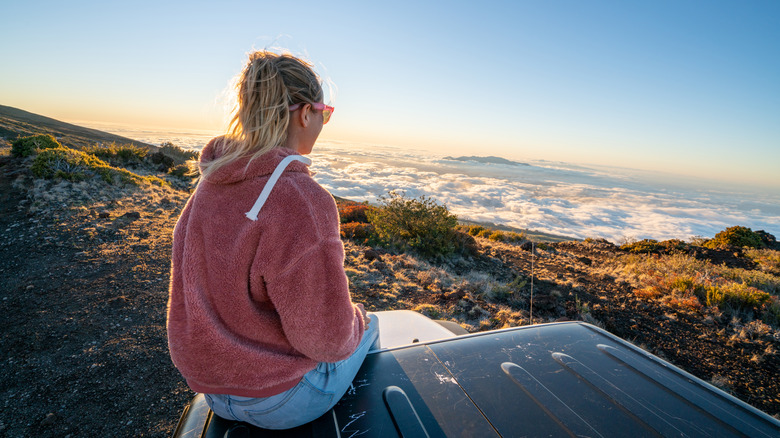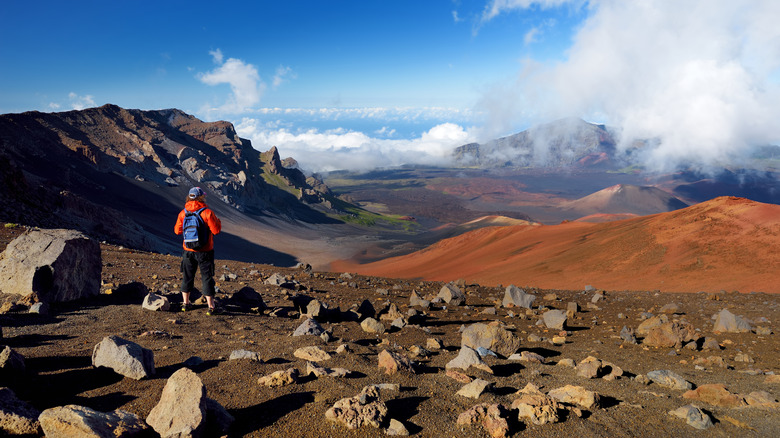Travel Guides Outdoor Adventures Hiking
Joshua St. James
Hawaii is renowned for its breathtaking natural sites, and one of the most spectacular is Haleakalā National Park. This park is home to an inactive shield volcano that last erupted over 400 years ago. The volcano’s crater now serves as the centerpiece of the national park and attracts hikers from around the globe.
The Sliding Sands Trail, also known as Keonehe’ehe’e Trail, is the most popular hike in the summit district of Haleakala National Park. It begins at Keonehe’ehe’e Trailhead, located at the summit of the volcano, which stands at an elevation of over 10,000 feet. From there, the trail descends into the crater, allowing hikers to explore this unique environment and enjoy stunning views. The trail is approximately 11 miles long and includes an elevation change of 3,000 feet. It concludes at Halemau’u, situated at an elevation of 7,990 feet. Along the trail, hikers have the opportunity to observe a variety of native plants, including the endangered Haleakalā Silversword.
Many visitors choose to visit the volcano’s summit during sunrise. Haleakalā translates to “house of the sun” and provides a chance for visitors to witness the legend of the Hawaiian demigod, Maui, firsthand. The park offers sunrise permits, which allow visitors to experience the sunrise from the top of the crater. Reservations are valid for one vehicle entrance and need to be made at least two days in advance, so planning your trip ahead of time is recommended.
Getting to the Sliding Sands Trail in Haleakalā National Park

Swissmediavision/Getty Images
Haleakalā National Park is located on the eastern portion of Maui and can be reached via Route 37 from the Kahului airport. The park is divided into two sections: the Kīpahulu District and the Summit District. To access Sliding Sands, visitors should enter the Summit District through Routes 377 to 378, while Route 360 takes visitors around the park’s east side into the Kīpahulu District.
Route 377, also known as Haleakalā Highway, offers a 37-mile journey to the summit. Once there, Route 378, a steep and winding road, leads directly to both the Park Headquarters Visitors Center and the Haleakalā Visitors Center, which provides access to the Sliding Sands Trailhead. Public transportation does not go up to either visitor center, so visitors must drive, bike, or arrange for a tour. It is important to drive with caution as the roads leading to the centers can be winding and narrow.
From the Haleakalā Visitors Center, the Sliding Sands Trail is just a half-mile walk from the summit. It is advisable to dress appropriately for the weather and bring plenty of water or other hydrating drinks. The visitor center offers restrooms, water, ample parking, and first aid if needed.
The Sliding Sands Trail hiking experience

Mnstudio/Getty Images
As you explore the crater, you will be surrounded by breathtaking views of otherworldly landscapes. The trail takes you through a variety of colors, ranging from deep reds to earthy browns and vibrant greens. This surreal scenery is the result of centuries of volcanic activity and erosion. The Sliding Sands Trail is a challenging trail that can give a false sense of security as it starts with a large, relatively easy descent from the trailhead into the crater.
About 3.7 miles down into the crater, you will come across one of three cabins available for reservation along the trail: the Kapalaoa Cabin. The other two cabins, Holua and Paliku, are located 5.5 miles and 9.3 miles from the trailhead, respectively. These cabins can be reserved online up to six months in advance, but they only offer a few facilities such as non-potable water, a pit toilet, and wood or propane stoves. While firewood can be purchased at the visitor center, you will need to bring a lighter or matches, as well as any additional drinking water or food required.
Whether you are hiking the Sliding Sands Trail round trip or staying overnight at one of the cabins, be aware of symptoms of altitude sickness when traveling to high-elevation areas. Take precautions such as acclimatizing, staying hydrated, and being mindful of your surroundings. The park also requires hikers to stay on the trail and practice Leave No Trace principles, including proper disposal of human waste and packing out any trash brought in.

